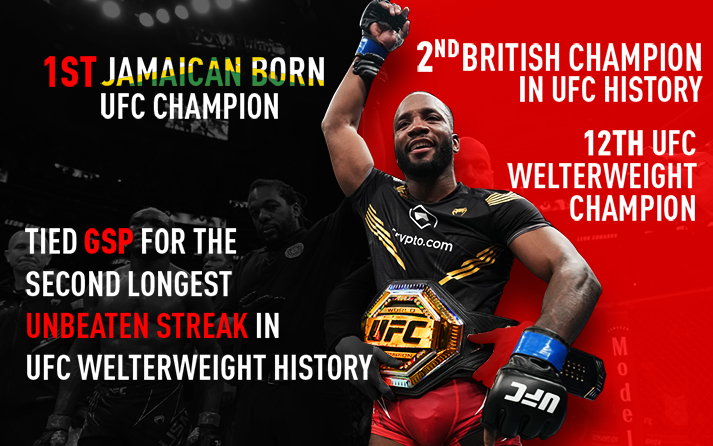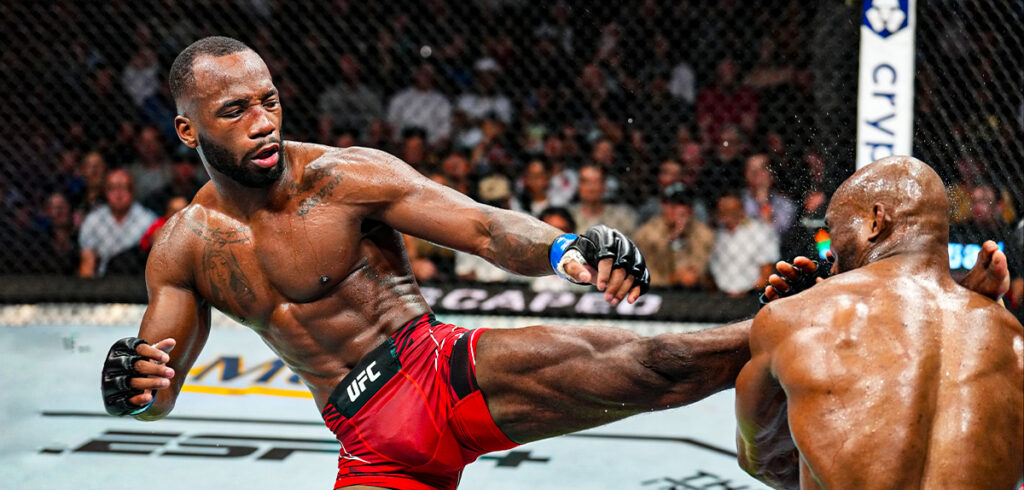Have you ever thrown a jab, hook, or kick at an imaginary opponent? Ever wondered how you could fight like a pro? You’re not the only one. As the world of combat sports continues to grow in popularity, many fans are looking for ways to get a closer look at the behind-the-scenes action that goes on during training sessions.
For those interested in the world of MMA, there are few better options than stepping onto the training mat or into the cage with a pro! The only better option is to do the same with a UFC pro fighter. And even better to do so with someone who is an elite fighter among elite fighters, someone like reigning UFC Champion Leon Edwards.

A highly skilled welterweight, Leon “Rocky” Edwards is a fighter known for his precision striking, wrestling and well-rounded skill set. Edwards is the perfect sparring partner for those looking to hone their skills and improve their technique.
With a variety of sparring drills, extraordinary grit, and fight simulations at his disposal, Edwards is able to help fighters of all skill levels prepare for the intense physical and mental challenges of the sport. Whether you’re a seasoned pro, an amateur, a fan, or just taking your first steps into the world of MMA, this simulated sparring with Leon Edwards is an experience you won’t soon forget.
In this blog, we are going to give you a sneak peak of the training insights that you have been searching for, and to help you inch closer to be the extraordinaire that we know as Leon Edwards.
Related Article: MMA Evolution: Strategy, Skills, and Conditioning
Leon Edwards’ Weight Room Workout
Mixed Martial Arts are undoubtedly one of the most physically demanding combat sports to exist. UFC pros, as a general rule, are elite fighters, and by extension, champions are usually considered at the very top of the ladder. And when it comes to UFC fighters and champions, extraordinary reserves of determination, physical endurance, and mental fortitude are the norm, not the exception.
That is exactly the kind of fighter you want to emulate if you want your fight skills to develop in any meaningful way. Leon Edwards is just such an aspirational fighter who inspired other fighters to have the same relentless drive to succeed as him.
Make no mistake, however, This drive doesn’t come easy. There’s a lot of hard work being put through to achieve the kind of record and the extensive winning streaks like that of Edwards.
The UFC champ started mixed martial arts training at the age of 17 in order to focus his energy on something productive and as a way to keep himself out of trouble. But with an immediately obvious striking potential, he started focusing on expanding his fighting skills by practising other disciplines as well, such as jiu-jitsu.
Today, he has reached the pinnacle among professional fighters. But striking remains his most potent weapon to date, winning him numerous victories, including against the former Welterweight champion and UFC Great, Kamaru ‘Nightmare’ Usman.
For someone looking to build the same kind of explosive power as Leon, his weight room workout routine can help you kickstart the energy that channels your inner kickboxer. Here’s how he works out:
Warmup
– Begin with a 5-minute treadmill session to warm up.
Chest and Back Superset
– Perform the following exercises consecutively with no or minimal rest, repeating for a total of 3 to 4 rounds:
- Bench Press – 20 reps
- Incline Dumbbell Row – 20 reps
Posterior Chain Superset
Execute these exercises back-to-back with minimal rest, repeating for a total of 3 to 4 rounds:
- Trap Bar Deadlift – 20 reps
- Med Ball Slams – 20 reps
Finisher
Conclude your warmup with a stationary Assault Bike:
– Perform 5 sets of 10-second sprints.
– Allow 20 seconds of rest between each sprint.
The Art of Sparring
Sparring is a crucial element in the training regimen of mixed martial artists (MMA) and fighters in various combat sports. It plays a pivotal role in developing and refining skills, improving fight IQ, and preparing athletes both mentally and physically.
Bagwork can help you with striking and grappling. But there is no substitute for a human sparring partner, particularly in terms of building takedown defense, counterpunching skills and general fight IQ development. A sparring session is as close as a real fighting scenario can be created outside of a real match.
It’s no secret that one of the ways Leon sharpens his dominant striking and wrestling skills is through extensive sparring. This not only helps him build extra physical conditioning but also helps him hone his mental acuity and awareness in a fight.
During sparring sessions, he is able to get a better understanding of his opponents’ tendencies and develop counter-strategies, especially with a sparring partner who has a fighting style similar to that of a UFC opponent.
Sparring in MMA is a process that requires him to be both critical and analytical of his own style, making him an even more formidable opponent in every fight. By putting in the time and effort to master his craft, Edwards reminds us how important it is to properly utilise this type of training to constantly improve and stay ahead of the competition.
Let’s have a more detailed look into the importance of sparring in an MMA fighter’s training and the different types of sparring commonly utilised:
Importance of Sparring in MMA
- Skill Development
Sparring is akin to a skill laboratory for fighters. It provides an environment where they can test, refine, and apply the techniques they’ve learned in training to a professional fight situation. This includes striking, grappling, takedowns, defence and submissions. It’s where they turn knowledge into muscle memory, ingraining strikes and counters into their body until they become almost automatic.
- Adaptability
MMA fighters need to be adaptable. Throughout their career, they face opponents with diverse styles. From kickboxers to Sambo experts to classic boxers to Muay Thai pros, the combinations available to a fighter in MMA are much higher than boxing, and sparring is the only consistent solution that allows a fighter like Leon Edwards to encounter different strategies and tactics while still coming out on top. This adaptability is a hallmark of successful fighters, and sparring is one of the surest ways to build yourself up to that level of skill.
- Mental Toughness
Stepping into the cage requires mental fortitude. MMA is a brutal and dangerous combat sport. Even with the right training and physical fitness levels, many fighters can fall victim to the psychological confrontations that are such a big part of combat sport. Sparring replicates the pressure and intensity of a real fight. It helps fighters to develop the mental resilience needed to stay composed under duress.
- Conditioning
While specific cardio and strength training are vital, nothing quite mimics the cardiovascular demands of a fight like sparring. A professional fight has more minutes and rounds than an amateur fight. That means professional rounds have much more room for action and it pushes fighters to their physical limits and improves their overall conditioning.
- Timing and Distance
MMA is a game of fractions of a second. Fighters must understand the timing of strikes, takedowns, and counters, as well as how to manage the distance between themselves and their opponents. Sparring is where they fine-tune these critical aspects.
Types of Sparring in MMA
- Technical Sparring
Technical sparring focuses on precision and form. Fighters practise specific techniques and combinations at a controlled pace. The emphasis is on correct execution rather than power.
- Live Sparring
Live sparring replicates real fight conditions as closely as possible. Fighters go full-force but with the intent of not causing severe injury to their training partners. This type of sparring is crucial for testing strategies, developing fight instincts, and building endurance.
- Controlled Sparring
Often used for beginners or during recovery periods, controlled sparring prioritises safety. Fighters use reduced power and aim to avoid injuring each other while still practising techniques.
- Specific Sparring
Specific sparring isolates certain aspects of the fight game, such as clinch work, ground and pound, or striking exchanges. It allows fighters to target and improve particular areas of their game.
- Technical-Flow Sparring
In this cooperative form of sparring, fighters move fluidly and work together. They focus on practising techniques, counters, and transitions in a controlled and supportive manner, emphasising the technical aspects of their craft.
- No-Gi Sparring
For MMA fighters with a background in grappling, such as Brazilian Jiu-Jitsu, no-gi sparring is essential. It emphasises grappling techniques without the traditional gi, aligning more with what they’ll encounter in MMA.
Drills & Training Sessions
MMA training involves a wide range of drills and techniques designed to enhance the skills required for success in the sport. Let’s explore some of the key drills and training sessions commonly used in MMA:
1. Striking Drills:
- Punch Mitts/Pad Work: Fighters work with a coach or training partner who holds focus mitts or Thai pads. This drill focuses on striking accuracy, combinations, and footwork.
- Heavy Bag Work: Hitting heavy bags allows fighters to practise power and precision while improving conditioning. It’s an essential part of striking training.
- Sparring: Live sparring sessions, as mentioned earlier, simulate real fight conditions, allowing fighters to practise their striking techniques against a resisting opponent. Wearing the right MMA gear is essential to ensure injury prevention and perfecting technique. Sparring gloves and mouthguard are some of the most important gear to use during your training sessions.
2. Take Down, Grappling and Ground-and-Pound Drills
- Takedown Drills:
- Double Leg Takedown:
– Fighters practise their double-leg takedown technique on partners.
– Focus on timing, level change, and explosiveness.
– Drills include taking down and transitioning to control on the ground.
- Single Leg Takedown:
– Similar to the double leg, but with a focus on single-leg takedown setups and finishes.
– Emphasises control of one opponent’s leg while maintaining balance.
- Clinch Work:
– Incorporates Muay Thai clinch and Greco-Roman clinch techniques for takedowns.
– Develops the ability to control an opponent in close quarters and initiate takedowns from the clinch.
- Grappling Drills:
- Submission Drills:
– Fighters work on various submission holds, such as armbars, chokes, and leg locks.
– Focus on technique, leverage, and transitioning between submissions.
- Positional Drills:
– Drills simulate specific positions, such as mount, side control, and back control.
– Fighters practice maintaining dominant positions and escaping from disadvantageous ones.
- Scrambling Drills:
– Emphasis on quick transitions and reversals to regain control.
– Teaches fighters how to react when their opponent attempts to escape or reverse positions.
- Ground-and-Pound Drills:
- Ground Striking Combos:
– Fighters practice striking combinations from dominant ground positions, such as mount or side control.
– Focus on accuracy and control to avoid leaving openings for escapes.
- Guard Passing with Strikes:
– Combines ground-and-pound with passing the opponent’s guard.
– Teaches fighters to advance their position while delivering effective strikes.
- Defensive Drills:
– Focuses on fighters’ ability to defend against ground-and-pound attacks.
– Teaches fighters how to protect themselves while looking for opportunities to escape or counter.
Conditioning and Strength Training:
- Circuit Training: Fighters go through a series of exercises (e.g., burpees, kettlebell swings, box jumps) to improve overall conditioning, strength, and endurance.
- Interval Training: High-intensity interval training (HIIT) is often used to mimic the intensity of a fight. It involves short bursts of intense exercise followed by brief rest periods.
- Sprint Drills: Sprinting is crucial for explosiveness and cardiovascular conditioning. Fighters often incorporate hill sprints, track sprints, or shuttle runs into their training.
Related Article: Lose Weight By Engaging Into MMA Workout
Kicking Drills
Roundhouse Kick:
- Fighters practise the roundhouse kick, targeting the opponent’s legs, body, or head.
- Focus on proper hip rotation, balance, and speed.
- Training partners can hold pads for target practice.
Front Kick (Teep):
- Teep kicks are used for maintaining distance and disrupting an opponent’s balance.
- Drills involve practising teep kicks to the body and legs of training partners.
- Emphasis on snapping the leg out quickly and maintaining a strong guard.
High-Low Kicking:
- Fighters alternate between targeting the opponent’s legs and head.
- Drills involve quickly switching between low kicks (leg kicks) and high kicks (head kicks) to keep the opponent guessing.
Heel Kicks:
- Heel kicks are often used as surprise attacks because of their less conventional trajectory.
- They are effective for targeting an opponent’s head or body, especially when the opponent is not expecting the strike.
- Heel kicks, or hook kicks, involve a circular motion where the fighter swings their heel around to strike the opponent. The heel is the primary point of contact, making it a unique and powerful strike.
Fight Simulation
Fight simulation is a crucial component of fight preparation in mixed martial arts (MMA). It involves replicating real fight scenarios as closely as possible during training to prepare a fighter mentally and physically for the challenges they’ll face in the cage. This concept plays a pivotal role in helping fighters like Leon Edwards sharpen their skills and strategize effectively. Here’s an overview of fight simulation and how it benefits fighters:
Concept of Fight Simulation
Fight simulation aims to recreate the intensity, unpredictability, and stress of an actual MMA fight. It involves replicating various aspects of a bout, including striking, grappling, cage control, and mental focus. The goal is to help fighters adapt to different scenarios, refine their game plans, and build the confidence needed to perform at their best.
Role in Fight Preparation
Fight simulation challenges fighters mentally, helping them become more resilient in high-pressure situations. It enables them to stay composed, make quick decisions, and overcome adversity. Other than this, they are excellent for game plan testing. Fight simulations allow fighters to test their game plans and tactics against live resistance.
They can fine-tune their strategies based on what works effectively during these sessions. Simulating fight conditions also pushes fighters to their physical limits, improving their cardiovascular endurance and overall fitness. This is essential for sustaining peak performance throughout a bout.
The Mentality of a Fighter
The mentality of a fighter is a critical component of their success in mixed martial arts (MMA). It encompasses various mental attributes and strategies that fighters like Leon Edwards and others develop to build their mental strength. Here’s an exploration of the mental aspects of training and how fighters cultivate their mental toughness:
1. Focus and Concentration:
Maintaining focus is essential for absorbing knowledge from coaches, perfecting techniques, and making quick decisions during a fight. Fighters practise mindfulness and concentration techniques to stay focused during long training sessions and remain in the present moment.
2. Determination and Resilience:
MMA is physically and mentally demanding. Determination and resilience enable fighters to push through adversity, stay committed to their goals, and bounce back from setbacks. Fighters develop mental toughness through gruelling workouts, sparring, and conditioning drills. They learn to embrace challenges and use setbacks as opportunities for growth.
3. Visualisation and Mental Rehearsal:
Visualisation involves mentally rehearsing techniques, strategies, and fight scenarios. It helps fighters build confidence and improve their performance by visualising success. It’s important for fighters to use visualisation techniques to imagine themselves executing perfect techniques, overcoming obstacles, and winning fights. This mental rehearsal helps enhance their self-belief and readiness.
4. Goal Setting:
Setting clear and achievable goals provides fighters with direction and motivation. It helps them measure progress and stay committed to their training. Fighters set both short-term and long-term goals, such as improving specific techniques or winning championships. These goals serve as a driving force in their daily training routines.
5. Mental Toughness and Resilience:
Mental toughness enables fighters to endure pain, fatigue, and discomfort during training and competition. It’s the ability to stay composed under pressure and adversity. To perform at their best in the octagon, fighters develop mental toughness through rigorous training sessions, exposure to challenging scenarios, and positive self-talk. They learn to embrace discomfort as part of the journey.
Leon’s Approach to Mental Fitness
Leon Edwards places significant importance on his mental well-being, acknowledging that mental exhaustion can be as debilitating as physical fatigue. He understands that his mental state profoundly impacts his performance in the cage.
To maintain optimal mental health, Edwards states that he stays mindful of avoiding pitfalls such as overtraining, overthinking, and overcomplicating his training and fight strategies. He believes in the power of simplicity and maintaining a strong focus during his preparation.
Additionally, Leon places immense value on his dedicated team, recognising their pivotal role in maintaining his mental and emotional equilibrium. His team serves as a valuable resource, engaging in discussions, posing thought-provoking questions, and providing a sounding board for ideas. They also play a crucial role in keeping him grounded and humble throughout his journey.
Conclusion
In conclusion, the world of MMA training, as exemplified by fighters like Leon Edwards, is a multifaceted journey that combines rigorous physical workouts, strategic sparring, diverse drills, and a strong emphasis on mental fortitude. The ideal harmony of dedication, simplicity, and teamwork creates champions. Through disciplined training, fight simulations, and a resilient mentality, fighters like Leon Edwards continually strive to achieve excellence in the octagon. By following the techniques and drills mentioned above, you can become a fighter just as aspirational as Edwards and create a legacy of your own!





